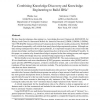25 search results - page 2 / 5 » Why Is Rule Learning Optimistic and How to Correct It |
AAAI
1998
13 years 9 months ago
1998
The "minimum margin" of an ensemble classifier on a given training set is, roughly speaking, the smallest vote it gives to any correct training label. Recent work has sh...
ICMI
2007
Springer
14 years 2 months ago
2007
Springer
Automatic distinction between posed and spontaneous expressions is an unsolved problem. Previously cognitive sciences’ studies indicated that the automatic separation of posed f...
IJCNN
2000
IEEE
14 years 10 hour ago
2000
IEEE
For unsupervised clustering in a network of spiking neurons we develop a temporal encoding of continuously valued data to obtain arbitrary clustering capacity and precision with a...
RAID
1999
Springer
14 years 20 days ago
1999
Springer
We have been developing a data mining (i.e., knowledge discovery) framework, MADAM ID, for Mining Audit Data for Automated Models for Intrusion Detection [LSM98, LSM99b, LSM99a]. ...
VL
2010
IEEE
13 years 6 months ago
2010
IEEE
Many machine-learning algorithms learn rules of behavior from individual end users, such as taskoriented desktop organizers and handwriting recognizers. These rules form a “prog...

